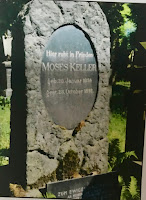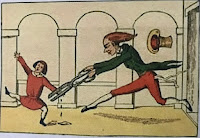À la recherche du temps perdu
At Jewish Newport
July 28, 2018
It was hot at Touro Synagogue, especially when the lights and fans went out. Rabbi Marc Mandel kept his sermon short.
“In the summer of 1852 the American poet, Henry Wadsworth Longfellow, brought his family from Cambridge, Mass to Newport for a vacation. Longfellow became entranced with Touro Synagogue’s cemetery up the street.
“He wrote a poem about it. Here are some short excerpts:
‘How strange it seems! These Hebrews in their graves,
Close by the street of this fair seaport town.
…
‘Closed are the portals of their Synagogue,
No Psalms of David now the silence break,
No Rabbi reads the ancient Decalogue
In the grand dialect the Prophets spake.
‘What once has been shall be no more
…
And the dead nations never rise again.’
“Today Longfellow was proven wrong. We did read the decalogue, the Ten Commandments. And we are not a dead nation. We’re here. We’re alive.
“If the Ten Commandments are so important, why aren't they part of our daily prayers?
“Well, that’s a trick question because the Talmud teaches us that they really are part of our prayers-they are incorporated into the Shema. The Shema and the Ten Commandments are very similar. And we read the Shema today too-the first paragraph.
“So this is one of the most important Torah readings of the year. Its also Shabbat Nachamu based on the Haftarah that Saul read. We pray for consolation. We pray for redemption-may we see it speedily in our time.
“Shabbat Shalom!”
Longfellow appeared to be very familiar with Judaism. His lack of sympathy might owe something to the times he lived in. America’s great future, which was believed to be a break with the past, was apparent. We Jews can boast of a great past, and do our best to make it part of our present. (Thanks to the Maine Historical Society for this insight.)
According to the Mishnah, during the Second Temple period the Ten Commandments were recited daily before the Shema. The Talmud explains that (Yerushalmi Berakhot, Chapter 1, fol. 3c), “It would be proper to read the Ten Commandments every day; and why don’t we? Because of the zeal of the heretics lest they say: These alone were given to Moses at Sinai.”
Over the years, our Rabbis have been concerned that we not elevate the Ten Commandments at the expense of observing the other commandments.
 Rabbi David Golinkin reviewed this in ‘Whatever Happened to the Ten Commandments?’ His grandfather, Rabbi Mordechai Golinkin, was a Rabbi in Dokshitz, where many Newporters trace their roots, in the 1920s. His headstone in Worcester, Massachusetts, says he was the rabbi and Av Bet Din of Zhytomyr, Dokshitz, Danzig and Worcester, and was on the Vaad Harabonim of Massachusetts.
Rabbi David Golinkin reviewed this in ‘Whatever Happened to the Ten Commandments?’ His grandfather, Rabbi Mordechai Golinkin, was a Rabbi in Dokshitz, where many Newporters trace their roots, in the 1920s. His headstone in Worcester, Massachusetts, says he was the rabbi and Av Bet Din of Zhytomyr, Dokshitz, Danzig and Worcester, and was on the Vaad Harabonim of Massachusetts. Ralph and Delia Klingbeil sponsored the Kiddish and spoke about their recent trip to Frankfurt and the Netherlands. The Klingbeil’s friend, Heidi Keller Moon, who also traces her routes to Jewish Frankfurt, accompanied them on the trip and joined us on Saturday.Ralph said, “This kiddish is dedicated to the chemical element lithium-atomic number 3 – for the 3 of us who journeyed together. Lithium is a soft, silvery-white alkali metal and it is the lightest metal and the lightest solid element. Like all alkali metals, lithium is highly reactive and flammable.”
Ralph and Delia Klingbeil sponsored the Kiddish and spoke about their recent trip to Frankfurt and the Netherlands. The Klingbeil’s friend, Heidi Keller Moon, who also traces her routes to Jewish Frankfurt, accompanied them on the trip and joined us on Saturday.Ralph said, “This kiddish is dedicated to the chemical element lithium-atomic number 3 – for the 3 of us who journeyed together. Lithium is a soft, silvery-white alkali metal and it is the lightest metal and the lightest solid element. Like all alkali metals, lithium is highly reactive and flammable.”At Frankfurt's Old Jewish Cemetery, Heidi visited the grave of her great grandfather, Moses Keller and a nearby memorial to a cousin of her of her father, who was murdered in Aushwitz.
 |
| The Philanthropin |
 |
| Freida Steinhauer |
 |
| Kaiserstraße 68 |
 |
| Kaiserstraße 68 today |
 The Jewish cemeteries in Frankfurt, to Ralph’s surprise, were not destroyed, and Ralph was able to place a stone from Mackerel Cove, Jamestown on the matzeva his grandfather, Louis Steinhauer, at the New Jewish Cemetery.
The Jewish cemeteries in Frankfurt, to Ralph’s surprise, were not destroyed, and Ralph was able to place a stone from Mackerel Cove, Jamestown on the matzeva his grandfather, Louis Steinhauer, at the New Jewish Cemetery.
When they went to eat, Ralph saw the sign for the Struwwelpeter Restaurant. Ralph recalled, “I experienced an involuntary and stunning memory flash of Struwwelpeter from almost 70 years ago. Struwwelpeter is a perverse, sadistic book for 3 to 6 year old children, written in 1845. One story is about trying to make a boy, Conrad, stop sucking his thumbs. The tailor and his scissors solve that problem. I loved the book and from about years 3 to 4 we were inseparable.”
 Der Struwwelpeter is one of the first modern illustrated children’s books. It’s ten stories about the results of children’s misbehavior. It was written by Heinrich Hoffmann in 1845 when he couldn’t find a good book for his 3 year old son. It’s a precursor to comic books, and has been translated into many languages, including English by Mark Twain.
Der Struwwelpeter is one of the first modern illustrated children’s books. It’s ten stories about the results of children’s misbehavior. It was written by Heinrich Hoffmann in 1845 when he couldn’t find a good book for his 3 year old son. It’s a precursor to comic books, and has been translated into many languages, including English by Mark Twain. Heinrich Hoffman was born in Frankfurt, where he became a psychiatrist. According to Wikipedia, he was skeptical whether his treatment was helping his patients, and was also skeptical about ideology, and was against religious, philosophical and political bigotry.
Heinrich Hoffman was born in Frankfurt, where he became a psychiatrist. According to Wikipedia, he was skeptical whether his treatment was helping his patients, and was also skeptical about ideology, and was against religious, philosophical and political bigotry.
Seeing the name of the restaurant and pictures on the walls of the book was enough to bring the childhood memory to Ralph’s mind.
 This is called an involuntary memory. The phrase was coined by Marcel Proust in his novel À la recherche du temps perdu (In Search of Lost Time). In the book, the protagonist recalled a memory after being served madeleines, a pastry.
This is called an involuntary memory. The phrase was coined by Marcel Proust in his novel À la recherche du temps perdu (In Search of Lost Time). In the book, the protagonist recalled a memory after being served madeleines, a pastry. “And as soon as I had recognized the taste of the piece of madeleine soaked in her decoction of lime-blossom which my aunt used to give me (although I did not yet know and must long postpone the discovery of why this memory made me so happy) immediately the old grey house upon the street, where her room was, rose up like a stage set to attach itself to the little pavilion opening on to the garden which had been built out behind it for my parents (the isolated segment which until that moment had been all that I could see); and with the house the town, from morning to night and in all weathers, the Square where I used to be sent before lunch, the streets along which I used to run errands, the country roads we took when it was fine (Proust, 1928).”
“And as soon as I had recognized the taste of the piece of madeleine soaked in her decoction of lime-blossom which my aunt used to give me (although I did not yet know and must long postpone the discovery of why this memory made me so happy) immediately the old grey house upon the street, where her room was, rose up like a stage set to attach itself to the little pavilion opening on to the garden which had been built out behind it for my parents (the isolated segment which until that moment had been all that I could see); and with the house the town, from morning to night and in all weathers, the Square where I used to be sent before lunch, the streets along which I used to run errands, the country roads we took when it was fine (Proust, 1928).”
The novel, which began to be published in 1913, took the world by storm, with it’s 3200 pages and 2000 characters. It was the first work to use stream of consciousness.
One of the memories we hold dear is that we were present at Sinai. This is so ingrained in our consciousness that it has become an involuntary memory, one that we can recall when we need to, for example, at a Passover seder. Rather than Proust's pastry, we stimulate our memories with matzah, moror and karpas.
Shabbat Shalom from Jewish Newport
 |
| The Steinhauer Family |


No comments:
Post a Comment